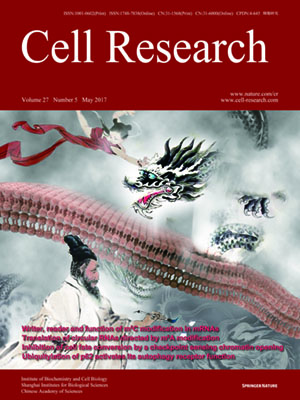
Volume 27, No 5, May 2017
ISSN: 1001-0602
EISSN: 1748-7838 2018
impact factor 17.848*
(Clarivate Analytics, 2019)
Volume 27 Issue 5, May 2017: 709-712
LETTERS TO THE EDITOR
Reversible transition between hepatocytes and liver progenitors for in vitro hepatocyte expansion
Han Wu1,*, Xu Zhou1,*, Gong-Bo Fu1,*, Zhi-Ying He3,*, Hong-Ping Wu2,*, Pu You4, Charles Ashton5, Xin Wang6, Hong-Yang Wang1,2 and He-Xin Yan1,2
1The International Cooperation Laboratory on Signal Transduction, Eastern Hepatobiliary Surgery Hospital, Second Military Medical University, Shanghai 200438, China
2National Center for Liver Cancer, Shanghai 200438, China
3Department of Cell Biology, Second Military Medical University, Shanghai 200433, China
4Naval Medicine Research Institute, Shanghai 200433, China
5Zilkha Neurogenetic Institute, University of Southern California, Los Angeles, CA 90033, USA
6The Key Laboratory of National Education Ministry for Mammalian Reproductive Biology and Biotechnology, Inner Mongolia University, Huhhot, Inner Mongolia 010070, China
Correspondence: Hong-Yang Wang, E-mail: hywangk@vip.sina.com; He-Xin Yan,(hexinyw@163.com)
Liver exhibits robust regeneration following mechanical damage due to immediate proliferation of hepatocytes. It has been recently reported that hepatocyte replenishment following liver damage could also occur via a reversible transition between hepatocytes and duct-like progenitor cells1. Hepatocyte-derived duct-like progenitor cells were observed to expand extensively in the presence of toxic insults and re-differentiate into functional hepatocytes upon cessation of injury1. This process was identified as ductal metaplasia of adult hepatocytes in vivo and described as an alternative mechanism for hepatocytes to escape from various chronic injuries1,2. Given the highly proliferative potential of the in vivo hepatocyte-derived progenitor cells, we sought to determine whether an optimal culture condition mimicking the in vivo milieu could be developed to extensively expand functional hepatocytes through reversible transition in vitro.
10.1038/cr.2017.47
FULL TEXT | PDF
Browse 1664


